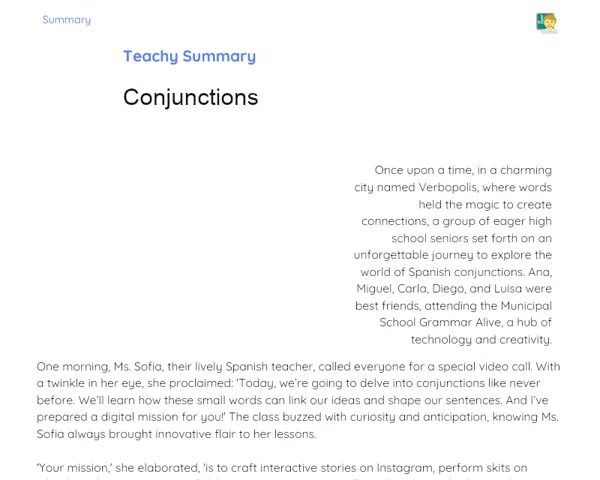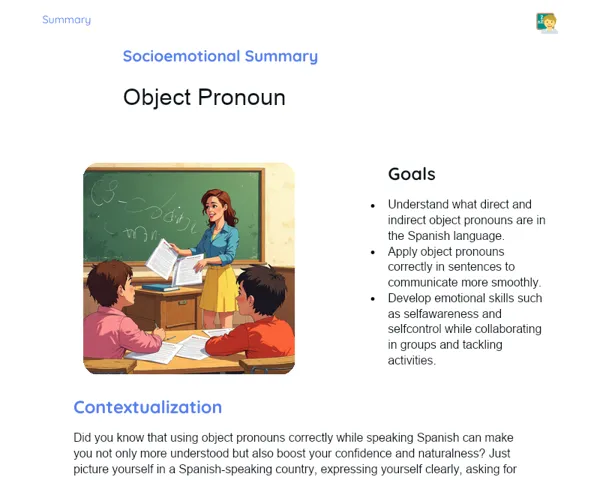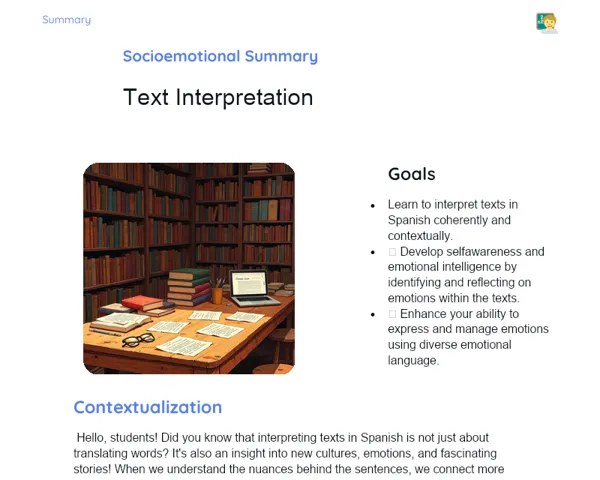Summary Tradisional | Word Formation
Contextualization
Word formation is a key aspect of learning any language, including Spanish. By adding prefixes and suffixes, we can create new words and change the meanings of existing ones. This skill is vital for expanding vocabulary and enhancing text comprehension, leading to more effective and nuanced communication. In Spanish, like in Portuguese, a lot of prefixes and suffixes have roots in Latin and Greek, making it easier for Portuguese speakers to pick up due to similarities between the two languages.
Grasping the processes of word formation is also critical for reading and understanding more intricate texts. For example, knowing that the prefix 'in-' implies negation can help us decipher that 'indescriptible' refers to something that cannot be described. Similarly, understanding that the suffix '-mente' turns adjectives into adverbs can clarify that 'rápidamente' means 'quickly.' This knowledge not only aids in comprehending unfamiliar words but also lays a strong groundwork for building a richer and more varied vocabulary in Spanish.
To Remember!
Prefixes
Prefixes are morphemes attached to the start of words to change their meanings. In Spanish, similar to Portuguese, prefixes are crucial for crafting new words and modifying the meanings of existing ones. They are particularly beneficial for expressing negation, repetition, opposition, and other concepts.
For instance, the prefix 'in-' indicates negation, as in 'injusto' (unjust) and 'invisible' (invisible). Another common prefix is 're-', which denotes repetition or intensity, as in 'releer' (to reread) and 'revisar' (to review). Additionally, the prefix 'des-' signifies opposition or reversal, as seen in words like 'deshacer' (to undo) and 'desconocido' (unknown).
Understanding prefixes helps students deduce the meanings of unfamiliar words and aids in forming new ones. This is particularly helpful in reading and interpreting Spanish texts, providing students with a better grasp of context and meanings.
-
Prefixes are attached to the start of words.
-
They alter the meanings of words.
-
Common prefixes in Spanish include 'in-', 're-', and 'des-'.
Suffixes
Suffixes are morphemes added at the end of words to change their meanings or grammatical functions. In Spanish, suffixes are commonly used to form nouns, adjectives, adverbs, and other word types. They are essential in structuring vocabulary and ensuring clear communication.
For example, the suffix '-ción' is used to form nouns from verbs, like 'educación' (education) and 'información' (information). The suffix '-mente' transforms adjectives into adverbs, as seen in 'rápidamente' (quickly) and 'fácilmente' (easily). Another example is the suffix '-ista', which represents profession or activity, as in 'periodista' (journalist) and 'artista' (artist).
Grasping suffixes enables students to identify the grammatical role of words and understand their meanings, which is particularly useful in academic and literary readings, where precise meaning is essential.
-
Suffixes are added to the end of words.
-
They change meanings or grammatical roles of words.
-
Common suffixes in Spanish include '-ción', '-mente', and '-ista'.
Derivation Processes
Derivation is a word formation method that involves adding prefixes and suffixes to a root to generate new words. In Spanish, this is a common strategy to broaden vocabulary and craft specific meanings from a shared root. This approach is fundamental for efficient language learning.
For instance, 'felicidad' is derived from 'feliz' by adding the suffix '-idad', turning the adjective into a noun. Similarly, 'desconocido' comes from 'conocido' with the prefix 'des-', indicating opposition. Another example is 'reconstrucción', which combines 're-' and 'construcción' to denote the repetition of the act of building.
Comprehending derivation processes allows students to identify patterns in word formation and apply these to decode unknown words. This is especially helpful in reading and interpreting complex texts.
-
Derivation involves adding prefixes and suffixes to a root.
-
It creates new words from a common root.
-
Examples include 'felicidad', 'desconocido', and 'reconstrucción'.
Composition Processes
Composition is a word formation process that entails blending two or more words to create a new word. In Spanish, this method is prevalent for forming words that describe objects, actions, or concepts more specifically. This process is crucial for vocabulary expansion and accurate communication.
For example, 'paraguas' is formed by merging 'para' (to protect) and 'aguas' (water), resulting in 'paraguas', meaning umbrella. Another instance is 'sacapuntas', which combines 'saca' (to take out) and 'puntas' (tips) to refer to a pencil sharpener. Additionally, 'abrelatas' is formed by combining 'abre' (to open) and 'latas' (cans), which refers to a can opener.
Understanding composition processes allows students to identify and create compound words, aiding in grasping and articulating complex concepts. This is particularly beneficial in both written and spoken communication, where clarity and precision are paramount.
-
Composition entails merging two or more words.
-
It generates words that depict specific objects, actions, or concepts.
-
Examples include 'paraguas', 'sacapuntas', and 'abrelatas'.
Key Terms
-
Prefixes: Morphemes added at the beginning of words to modify their meaning.
-
Suffixes: Morphemes added at the end of words to change their meaning or grammatical role.
-
Derivation: A word formation method by adding prefixes and suffixes to a root.
-
Composition: A word formation method by merging two or more words.
-
Reduction: A word formation method that creates shorter words from longer expressions.
Important Conclusions
In this lesson, we explored the fundamental processes of word formation in Spanish, including prefixes, suffixes, derivation, composition, and reduction. We learned that prefixes are added to the start of words to change their meanings, while suffixes are affixed at the end to alter either meaning or grammatical function. Derivation involves appending prefixes and suffixes to a root to create new words, and composition combines two or more words to form a new one. Lastly, reduction generates shorter words from longer ones.
Grasping these processes is essential for enhancing vocabulary and improving communication in Spanish. Knowing prefixes and suffixes enables one to infer meanings of unfamiliar terms, while the derivation and composition methods assist in spotting patterns in word formation. This understanding is particularly useful when reading and interpreting complex texts, where meaning precision is imperative.
I encourage you to delve deeper into this topic, as mastering word formation processes can greatly ease the learning of Spanish. Keep practicing and applying your knowledge in real-world communication scenarios, whether it's reading, writing, or conversing in Spanish. The more familiar you become with these concepts, the more confident and adept you will be in utilizing the language.
Study Tips
-
Regularly review common prefixes and suffixes in Spanish and experiment with forming new words from them.
-
Practice reading Spanish texts, focusing on how derivation and composition impact word formation.
-
Leverage exercises and activities found in specialized books and online resources to strengthen your knowledge of word formation.



